| Faisal Mosque | |
|---|---|
| فیصل مسجد | |
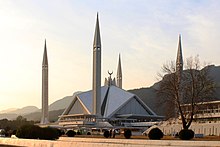 | |
| Religion | |
| Affiliation | Islam |
| Location | |
| Location | Islamabad |
| Municipality | Capital Development Authority |
| Country | Pakistan |
 | |
| Administration | International Islamic University, Islamabad |
| Geographic coordinates | 33°43′48″N 73°02′18″E / 33.729944°N 73.038436°E / 33.729944; 73.038436 |
| Architecture | |
| Architect(s) | Vedat Dalokay |
| Type | Mosque |
| Style | Modern Islamic |
| Date established | 1986 |
| Construction cost | US$120 million |
| Specifications | |
| Capacity | 300,000 worshippers |
| Minaret(s) | 4 |
| Minaret height | 90 m (300 ft) |
| Site area | 130,000 m; 1,400,000 sq ft |
The Faisal Mosque (Urdu: فیصل مسجد, romanized: faisal masjid) is the national mosque of Pakistan, located in the capital city, Islamabad. It is the fifth-largest mosque in the world, the largest mosque outside the Middle East, and the largest within South Asia, located on the foothills of Margalla Hills in Islamabad. It is named after the late King Faisal of Saudi Arabia. The mosque features a contemporary design consisting of eight sides of concrete shell and is inspired by the design of a typical Bedouin tent.
A major tourist attraction in Pakistan, the mosque is a contemporary and influential piece of Islamic architecture. Famous spots like the Faisal Mosque, a masterpiece of modern Islamic architecture, and the Pakistan Monument, which represents the country’s cultural history, add to the city’s charm.
Construction of the mosque began in 1976 after a $28 million grant from Saudi King Faisal, whose name the mosque bears. The unconventional design by Turkish architect Vedat Dalokay was selected after an international competition. Without a typical dome, the mosque is shaped like a Bedouin tent, surrounded by four 260 feet (79 m) tall minarets. The design features eight-sided shell shaped sloping roofs forming a triangular worship hall which can hold 10,000 worshippers.
Combined the structure covers an area of 33 acres (130,000 m; 1,400,000 sq ft), the mosque dominates the landscape of Islamabad. It is situated at the north end of Faisal Avenue, putting it at the northernmost end of the city and at the foot of Margalla Hills, the westernmost foothills of the Himalayas. It is located on an elevated area of land against a picturesque backdrop of the national park. Faisal Mosque was the largest mosque in the world from 1986 until 1993 when it was overtaken by the mosques in Saudi Arabia. Faisal Mosque is now the sixth largest mosque in the world in terms of capacity.
History
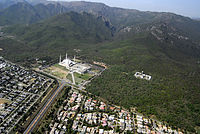 Aerial view
Aerial view View from Faisal Avenue in Islamabad
View from Faisal Avenue in Islamabad
The impetus for the mosque began in 1966 when King Faisal bin Abdul-Aziz supported the initiative of the Pakistani Government to build a national mosque in Islamabad during an official visit to Pakistan. In 1969, an international competition was held in which architects from 17 countries submitted 43 proposals. The winning design was that of Turkish architect Vedat Dalokay. Forty-six acres of land were assigned for the project and the execution was assigned to Pakistani engineers and workers. Construction of the mosque began in 1976 by National Construction Limited of Pakistan, led by Azim Khan and was funded by the government of Saudi Arabia, at a cost of over 130 million Saudi riyals (approximately 120 million USD today). King Faisal bin Abdul Aziz was instrumental in the funding, and both the mosque and the road leading to it were named after him after his assassination in 1975. King Faisal bin Abdulaziz's successor King Khalid laid the foundation stone for the mosque in October 1976 and signed the construction agreement in 1978. Basic information about the mosque can be found written on the foundation stone. On 18 June 1988, the first prayer was held, although the mosque was completed in 1986. The mosque grounds along with being a building for prayer also used to house the International Islamic University some years ago but has since relocated to a new campus in 2000. Some traditional and conservative Muslims criticized the design at first for its unconventional design and lack of a traditional dome structure.
Capacity
 Interior view
Interior view
The Faisal Mosque can accommodate about 300,000 worshippers. Each of the Mosque's four minarets are 79 m (230 ft) high (the tallest minarets in South Asia) and measure 10×10 meters in circumference. The main areas have the capacity to hold up to 74000 people in the main areas including the inner hall, and the courtyards. The grounds around the mosque have the capacity to contain up to 200,000 people.
Architecture
I tried to capture the spirit, proportion, and geometry of Kaaba in a purely abstract manner. Imagine the apex of each of the four minarets as a scaled explosion of four highest corners of Kaaba – thus an unseen Kaaba form is bounded by the minarets at the four corners in a proportion of height to base. Shah Faisal Mosque is akin to the Holy Kaaba in the designer's imaginative eyes. Now, if you join the apex of each minaret to the base of the minaret diagonally opposite to it correspondingly, a four-sided pyramid shall be bound by these lines at the base side within that invisible cube. That lower level pyramid is treated as a solid body while four minarets with their apex complete the imaginary cube of Kaaba.
— Vedat Dalokay, "Dalokay further explaining the thinking behind the design of the Masjid to students of a design school"

Instead of using traditional domes, Vedat Dalokay designed an eight-sided main hall that looked like an Arab's Bedouin desert tent. Additionally, he added four minarets on all four corners of the main hall, which are of 80 m (260 ft) high, the tallest minarets in South Asia. The main structure of the building is the main prayer hall, which is supported by four concrete girders. The four unusual minarets are inspired by Turkish architecture. Vedat Dalokay also believed that the design of the Masjid represents Kaaba in an abstract manner. Entrance is from the east, where the prayer hall is fronted by a courtyard with porticoes. The International Islamic University was housed under the main courtyard but now has relocated to a new campus. The mosque still houses a library, lecture hall, museum, and cafe. The interior of the main tent-shaped hall is covered in white marble and decorated with mosaics and calligraphy by the famous Pakistani artist Sadequain, and a Turkish-style chandelier. The mosaic pattern adorns the west wall and has the Kalimah written in early Kufic script, repeated in mirror image pattern.
The Qibla Wall is covered with blue and white calligraphic tiles designed by a Turkish artist Mengu Ertel. The interior of the mosque uses Turkish and Pakistani inspired decorations. The mosque takes an unusual route to its design by combining contemporary and classic Islamic architecture. The unique design takes most of its elements from nomadic Bedouin tent, but it still manages to keep in contact with Islamic architecture by using Ottoman style minarets and square shape form the Kaaba.
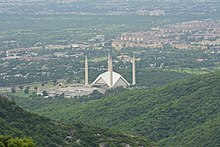
Topography
Located at the foot of the Margalla Hills, the location plays a significant role in Faisal Mosque. The Mosque is visible from miles away and sits on a higher surface compared to the main city. The mosque faces the city and is backed by green mountain ranges, giving it a scenic view. One of the main highways of Islamabad, Faisal Avenue leads straight to the Mosque showing the importance of the landmark. The shining white color in comparison to the dark green background makes the mosque stand out and reveal its significance to the city of Islamabad.
References in literature
The Faisal Mosque is described in the book The Kite Runner by Khalid Hosseini. It is frequently referenced in the work of Michael Muhammad Knight, who came to the mosque to study Islam as a teenager.
Gallery
-

-

-
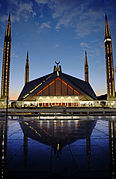 Portrait
Portrait
-
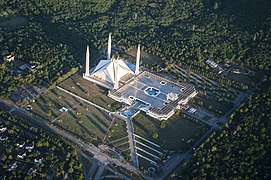 Aerial view
Aerial view
-
 The mosque and Snow-capped Margalla Hills
The mosque and Snow-capped Margalla Hills
-
Elevation view of the mosque
-
 During 27th Ramadan
During 27th Ramadan
-

-
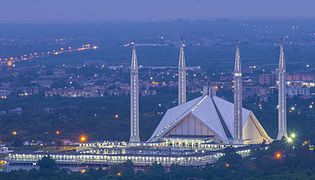 From Daman-e-Koh
From Daman-e-Koh
-
 View from Margalla Hills
View from Margalla Hills
-
 View before sunset
View before sunset
-
 The mosque at night during prayer times
The mosque at night during prayer times
-
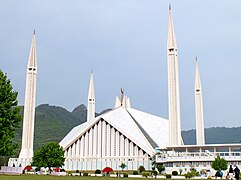 Faisal Masjid in cloudy weather
Faisal Masjid in cloudy weather
-
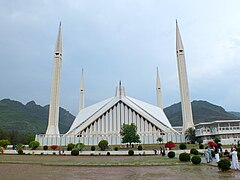 Faisal Masjid front view
Faisal Masjid front view
-
View of Faisal Mosque and Jamia Faridia from Daman-e-Koh, Islamabad
-
 Faisal Masjid at twilight
Faisal Masjid at twilight
-
 Faisal mosque main hall chandelier
Faisal mosque main hall chandelier
See also
- Badshahi Mosque
- Islamic art
- List of mosques in Pakistan
- List of largest mosques
- List of things named after Saudi Kings
- Timeline of Muslim history
- Minar-e-Pakistan
References
- Len McGrane (January–February 1992). "A Mosque in Islamabad". Saudi Aramco World magazine. Aramco Services Company. Archived from the original on 18 February 2007. Retrieved 29 November 2007.
- Neelam Naz (13 September 2005). "Contribution of Turkish architects to the national architecture of Pakistan: Vedat Dalokay" (PDF). Journal of the Faculty of Architecture. 22 (2). Ankara, Turkey: Middle East Technical University: 56–64. Archived from the original (PDF) on 23 November 2018. Retrieved 29 November 2007.
- "Three Pakistani mosques make it to 'world's most beautiful mosques' list". The Express Tribune. 3 August 2015. Retrieved 2 March 2021.
- ^ "King of All Mosques – Faisal Mosque". HOPES. 6 November 2015. Retrieved 17 December 2019. Cite error: The named reference "HOP" was defined multiple times with different content (see the help page).
- ^ "Faisal Mosque attracts visitors from all over country". The News International. Retrieved 17 December 2019.
- ^ "Faisal Mosque not a 'gift' by Saudi Arabia". Daily Times. 13 February 2017. Retrieved 8 August 2020.
- Mass, Leslie Noyes (2011). Back to Pakistan: A Fifty-Year Journey. Rowman & Littlefield. p. 157. ISBN 978-1-4422-1319-7.
- "Faisal Mosque – Islamabad, Pakistan". www.sacred-destinations.com. Retrieved 17 December 2019.
- "Shah Faisal Mosque in Islamabad & Rawalpindi". Lonely Planet. Retrieved 17 December 2019.
- "Three Pakistani mosques make it to 'world's most beautiful mosques' list". The Express Tribune. 3 August 2015. Retrieved 2 March 2021.
- Rengel, Marian (2004). Pakistan: A Primary Source Cultural Guide. Rosen. p. 71. ISBN 978-0-8239-4001-1.
- Mujtaba Razvi (1981). "PAK-Saudi Arabian Relations: An Example of Entente Cordiale" (PDF). Pakistan Horizon. 34 (1): 81–92. JSTOR 41393647.
- ^ "Faisal Mosque". archnet.org. ArchNet website. Retrieved 12 February 2019.
- "Here are the top 5 places to visit in Islamabad". Global Village Space. 11 August 2021. Retrieved 16 April 2022.
- Faisal Mosque, Islamabad - From Pakistan Embassy in Tokyo Website Retrieved 17 December 2019
- "Faisal Mosque, Islamabad". Pakistan Embassy Tokyo Japan.
- Profile of the Faisal Mosque architect on Pakistan Today 17 August 2012, Retrieved 17 December 2019
- Faisal Mosque on Pakistan Tours Guide website Published 15 August 2012, Retrieved 17 August 2019
- Rizvi, Kishwar (2015). The Transnational Mosque: Architecture and Historical Memory in the Contemporary Middle East. University of North Carolina Press. doi:10.5149/northcarolina/9781469621166.001.0001. ISBN 978-1-4696-2116-6.
- Arif, Muhammad; Ilyas SindH, Muzammal; Ullah Khan, Inayat; Urooj, Syeda Faiza (1 July 2016). "Antecedents and Outcomes of Knowledge Management Practices: Evidence from Pakistan". Jinnah Business Review. 4 (2): 23–29. doi:10.53369/zxrc5451. ISSN 2070-0296.
- "Faisal Mosque". Atlas Obscura. Retrieved 7 December 2021.
- "Faisal Mosque, Islamabad | Pakistan Embassy Tokyo Japan". www.pakistanembassytokyo.com. Retrieved 7 December 2021.
- "Inspired By a Bedouin's Tent: The Faisal Mosque in Islamabad Was Designed By a Turkish Architect". MVSLIM. 24 February 2019. Retrieved 7 December 2021.
- Religions of the world: a comprehensive encyclopedia of beliefs and practices. 1 March 2011.
- The world's most beautiful mosques The Telegraph (United Kingdom). Retrieved 4 September 2021
| National symbols of Pakistan | |
|---|---|
| Main symbols |
|
| People |
|
| Other symbols |
|
| Structures |
|
| Gilgit-Baltistan | |
|---|---|
| Islamabad | |
| Khyber Pakhtunkhwa | |
| Punjab | |
| Sindh | |
| List of cultural heritage sites in Islamabad Capital Territory | |
|---|---|
| Forts | |
| Tourist attractions | |
| Archaeological sites | |
| Museums | |
| Monuments | |
| Government secretariats | |
| Other sites | |